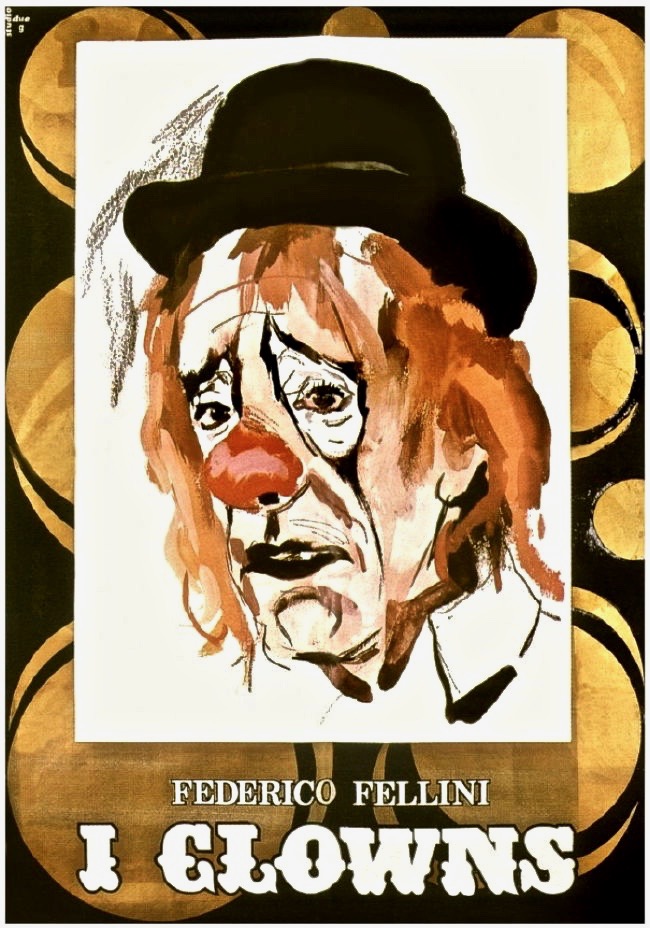I clowns
Year: 1970
Format: Colour
Runtime: 93 min
Production: Rai – Radio Televisione Italiana (Italia) – O.R.T.F. (Francia) – Bavaria Film (R.F.T.) Compagnia Leone cinematografica
Word sales: Italnoleggio
Viewed censorship: 5707217/10/1970
A circus tent is being installed and a child looks on curiously. Clowns remind him of some real-life characters, including an energetic dwarf, “Cotechino”, the stationmaster, “Madonna”, who’s continuously quarrels with her colleagues, “Giudizie”, who’s going back to World War I…We then move on to the present day. A television investigation is under way, and Fellini is looking for old clowns and is willing to listening to them telling him their memories. After visiting the “Liana Orfei” circus, Fellini and his crew go to Paris, where they interview Tristan Remy, a writer dealing mainly with clowning history. Fellini helps the writer track old clowns, namely the few survivors of a no longer existing world. The Director shoots their aged and sad faces. He owes them the joy they were capable of giving their audience.
poster – courtesy of © Webphoto & Services



Crew
Director: Federico Fellini
Story: Federico Fellini, Bernardino Zapponi
Screenplay: Federico Fellini, Bernardino Zapponi
Cinematography: Dario Di Palma (Technicolor)
Camera operator: Blasco Giurato
Music: Nino Rota
Musical director: Carlo Savina
Costume design: Danilo Donati
Film editing: Ruggero Mastroianni
Assistant editor: Adriana Olasio
First assistant director: Maurizio Mein
Second assistant director: Liliana Betti
Script supervisor: Norma Giacchero
Makeup artist: Rino Carboni
Special effects: Adriano Pischiutta
Hair Stylist: Paolo Franceschi
Production design: Renzo Gronchi
Set decorator: Renzo Gronchi
Mixage : Alberto Bartolomei
Producer: Elio Scardamaglia, Ugo Guerra
Production manager: Lamberto Pippia
Cast
Liana Orfei : se stessa
Rinaldo Orfei : se stesso
Nando Orfei : se stesso
Franco Migliorini : se stesso
Anita Ekberg : se stessa
Billi : clown
Scotti : clown
Fanfulla : clown
Reder : clown
Valentini : clown
Merli : clown
Rizzo : clown
Pistoni : clown
Furia : clown
Sbarra : clown
Carini : clown
Terzo : clown
Vingelli : clown
Fumagalli : clown
Zerbinati : clown
I 4 Colombaioni : clowns
I Martana : clowns
Maggio : clown
Janigro : clown
Maunsell : clown
Peverello : clown
Sorrentino : clown
Valdemaro : clown
Bevilacqua : clown
Maya Morin : la troupe
Lina Alberti : membro della troupe
Alvaro Vitali : membro della troupe
Gasparino : membro della troupe
Alex : clown francese
Bario : clown francese
Père Loriot : clown francese
Ludo : clown francese
Charlie Rivel : clown francese
Maiss : clown francese
Nino : clown francese
Pierre Etaix : se stesso
Victor Fratellini : se stesso
Annie Fratellini : se stessa
Baptiste Rémy : se stesso
Tristani Rémy : se stesso
Pipo : se stesso
Rhum : se stesso
Buglioni : se stesso
Hugue : se stesso
Awards
1971
Silver ribbon for Best Costume Design
Peculiarites
“When I say: ‘the clown’, I mean the August. There are in fact two figures: White and August clowns. The White clown personifies elegance, grace, harmony, intelligence, brightness – all traits that are described as ideal and unique traits. The White clown thus becomes the Mother, the Father, the Master, the Artist, the Handsome one – to sum up – ‘what has to be done’. Consequently the August clown, who would be under the spell of these perfect traits, rebels. He sees shining ‘sequins’ on costumes, but their snootiness makes them unattainable. The August clown is the child who soils himself; he’s the one who gets drunk, rolls on the ground and continuously raises objections. This is the fight between reason and instinct, reason and the freedom of instinct.” The White clown and the August clown are the Primary School Teacher and the Child, the Mother and the Little Rogue. We may even say they are the Angel with a blazing sword and the Sinner.”
(Federico Fellini, Fare un film, Einaudi, Torino, 1980, p. 117)
Reviews
“There is a bit of everything in these Clowns: Anita Ekberg’s feline appearances circus Orfei’s cages, and the whole of Fellini’s talent. The main elements of Fellini’s creativeness are all there, his sweet and nasty traits, his modesty, his affection, his credulity and skepticism”.
(Guglielmo Biraghi, “Il Messaggero”, 31 August 1970)


